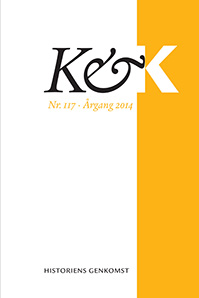NATIONALHISTORIE EFTER MODERNISMEN - FOLKEBEGREBET I LYSET AF EUROPAS STORE FORTÆLLINGER
DOI:
https://doi.org/10.7146/kok.v42i117.17566Nøgleord:
nation, people, nation-state, national identities, national history, modernism, nationalism, monarchyResumé
WRITING NATIONAL HISTORY AFTER MODERNISM: THE HISTORY OF PEOPLEHOOD IN LIGHT OF EUROPEAN GRAND NARRATIVES | The purpose of the article is to refute the recent claim that Danish history cannot be written on the assumption of the existence of a Danish people prior to 19th-century nationalism. The article argues that, over the past twenty years, scholars in pre-modern European history have highlighted the limitations of the modernist paradigm in the study of nationalism and the history of nations. For example, modernists have difficulties explaining why a Medieval chronicle such as Saxo Grammaticus’s Gesta Danorum was translated in the mid-1600s, and why it could be used for new purposes in the 1800s, if there had not been a continuity in notions of peoplehood between the Middle Ages and the Modern Age. Of course, the claim of continuity should not be seen as an argument for an identity between the “Danes” of Saxo’s time and the Danes of the 19th-century Danish nation-state. Rather, the modern Danishness should be understood as the product of a historical process, in which a number of European cultural narratives and state building played a significant role. The four most important narratives of the Middle Ages were derived from the Bible, which was a rich treasure of images and stories of ‘people’, ‘tribe’, ‘God’, King, ‘justice’ and ‘kingdom’ (state). While keeping the basic structures, the meanings of these narratives were re-interpreted and placed in new hierarchical positions in the course of time under the impact of the Reformation, 16th-century English Puritanism, Enlightenment patriotism, the French Revolution and 19th-century romantic nationalism. The article concludes that it is still possible to write national histories featuring ‘the people’ as one of the actors. But the historian should keep in mind that ‘the people’ did not always play the main role, nor did they play the same role as in previous periods. And even though there is a need to form syntheses when writing national history, national identities have always developed within a context of competing and hierarchical narratives. In Denmark, the ‘patriotist narrative’ seems to be in ascendancy in the social and cultural elites, but has only partly replaced the ‘ethno-national’ narrative which is widespread in other parts of the population. The ‘compact narrative’ has so far survived due the continued love of the people for their monarch. It may even prove to provide social glue for a sense of peoplehood uniting ‘old’ and ‘new’ Danes.
Downloads
Citation/Eksport
Nummer
Sektion
Licens
Tidsskriftet følger dansk ophavsret.





